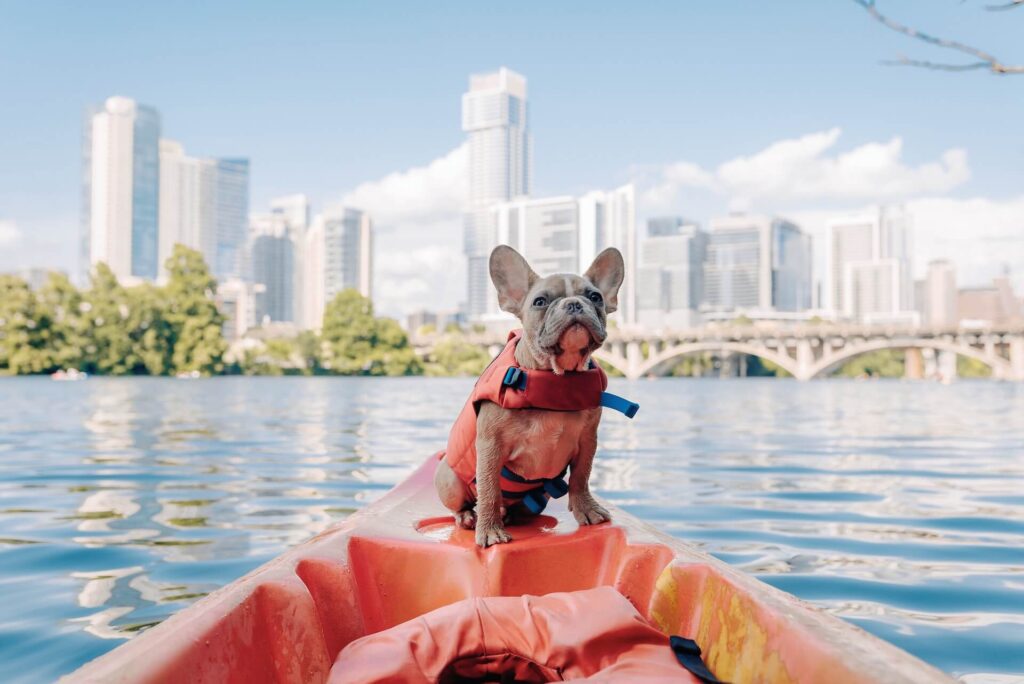
I. Introduction
Traveling with pets can be a fun and rewarding experience, but it can also be stressful and challenging if not planned properly. Whether you’re embarking on a road trip with your dog or taking your cat on a plane, there are a number of factors to consider to ensure a smooth and stress-free journey for both you and your pet.
In this article, we’ll provide you with some valuable tips and insights on how to prepare for and manage your pet’s travel, including choosing the right mode of transportation, booking pet-friendly accommodations, and managing your pet’s behavior and anxiety. We’ll also cover some legal and regulatory considerations involved in traveling with pets, such as vaccination and documentation requirements.
A. Why travel with your pet?
For many pet owners, the idea of traveling without their furry friends is unthinkable. Bringing your pet along on your travels can be a great way to bond with them and create special memories together. Moreover, leaving your pet behind can cause anxiety and stress for both you and your pet.
Traveling with your pet can also enhance your travel experience. Many pet-friendly destinations offer unique activities and attractions for pet owners and their pets to enjoy together. From hiking trails and dog parks to pet-friendly beaches and cafes, there are many opportunities to explore and discover new places with your pet.
B. Challenges of traveling with pets
While traveling with your pet can be a rewarding experience, it can also present many challenges. One of the biggest challenges is ensuring your pet’s safety and comfort during travel. Depending on the mode of transportation and destination, traveling with your pet can expose them to new environments, people, and animals, which can be stressful or overwhelming for some pets.
Another challenge is finding pet-friendly accommodations and services. Not all hotels, restaurants, and attractions are pet-friendly, which can limit your options when planning your trip. Additionally, traveling with pets can be costly, as many airlines and accommodations charge extra fees for pets.
C. The importance of planning ahead
To ensure a stress-free and enjoyable trip with your pet, it is important to plan ahead. Advance planning can help you anticipate potential challenges and take steps to address them. Some things to consider when planning your pet-friendly trip include:
- Assessing your pet’s readiness to travel
- Choosing the right mode of transportation
- Booking pet-friendly accommodations
- Packing essentials for your pet
By preparing well in advance, you can help minimize the challenges of traveling with your pet and maximize the fun and bonding opportunities that come with it.

II. Preparing for the Trip
Preparing for the trip involves assessing your pet’s readiness to travel, choosing the right mode of transportation, booking pet-friendly accommodations, and packing essentials for your pet. It’s important to take the necessary steps to ensure a stress-free and comfortable journey for both you and your furry friend. In this section, we’ll provide you with tips and insights on how to prepare for your pet’s travel, so you can both enjoy your trip to the fullest.
A. Assessing your pet’s readiness to travel
Before embarking on a trip with your pet, it is important to assess their readiness to travel. This involves considering your pet’s health, behavior, and temperament. If your pet has a pre-existing medical condition, it is important to consult with your veterinarian to ensure that they are fit to travel. Additionally, if your pet is prone to anxiety or motion sickness, you may need to take extra precautions to keep them comfortable and calm during the trip.
It is also important to make sure that your pet is up-to-date on their vaccinations and has any required documentation for travel, such as health certificates or proof of rabies vaccination. This is particularly important for international travel, as different countries may have different requirements for pets entering or leaving the country.
B. Choosing the right mode of transportation
Choosing the right mode of transportation is crucial when traveling with your pet. Some options include:
- Driving: If you are traveling within a reasonable distance, driving can be a good option for pet owners. It allows you to have more control over your pet’s environment and make stops as needed for exercise, bathroom breaks, and feeding.
- Flying: If you are traveling long distances or internationally, flying may be the most efficient option. However, it is important to research airlines’ pet policies and fees, as well as their restrictions on pet size and breed.
- Train or bus: Some train and bus companies allow pets onboard, but their policies and restrictions may vary. It is important to research these policies and make arrangements in advance.
C. Booking pet-friendly accommodations
When booking accommodations for your trip, it is important to find pet-friendly options. Many hotels, vacation rentals, and campgrounds allow pets, but it is important to confirm their policies and any associated fees in advance. Additionally, it may be helpful to research nearby pet-friendly activities and attractions to ensure that you and your pet have plenty to do during your stay.
D. Packing essentials for your pet
When packing for your trip, it is important to bring along essentials for your pet. These may include:
- Food and water: Bring enough food and water for the duration of your trip, as well as bowls for feeding and drinking.
- Bedding: Bringing your pet’s bed or a familiar blanket can help them feel more comfortable in a new environment.
- Medications and first-aid supplies: If your pet takes any medications or has special health needs, make sure to pack these along with any necessary supplies, such as a first-aid kit.
- Toys and treats: Bringing along familiar toys and treats can help keep your pet entertained and provide a sense of familiarity.
By assessing your pet’s readiness, choosing the right mode of transportation, booking pet-friendly accommodations, and packing essentials for your pet, you can help ensure a smooth and enjoyable trip for both you and your furry companion.

III. During the Trip
During the trip, it’s important to prioritize your pet’s safety and comfort while on the road. This section covers important tips for managing your pet’s behavior and anxiety, feeding and exercising your pet, and handling emergencies and health issues that may arise while traveling. We’ll also provide you with safety tips to ensure your pet stays secure while on the road. By following these tips, you can help ensure a smooth and enjoyable travel experience for both you and your furry friend.
A. Safety tips for pets while on the road
When traveling with your pet, it is important to prioritize their safety while on the road. Some safety tips include:
- Securing your pet: While driving, pets should be secured in a carrier or harness to prevent them from moving around and becoming a distraction to the driver. It can also help keep them safe in case of an accident.
- Never leave your pet alone in a parked car: Even if the weather is mild, leaving your pet in a parked car can quickly become dangerous as temperatures can rise or fall rapidly.
- Properly ventilate the car: Make sure the car is well-ventilated and never leave your pet in a closed trunk or other enclosed space.
- Rest and hydration: Make frequent stops to allow your pet to rest, stretch their legs, and have access to water.
B. Managing your pet’s behavior and anxiety
Traveling can be stressful for pets, particularly if they are not used to it. To help manage your pet’s behavior and anxiety during the trip:
- Provide comfort: Bring along familiar items, such as toys and bedding, to help your pet feel more comfortable in new environments.
- Practice crate training: If your pet is not used to traveling in a crate, practice crate training at home before the trip to help them become accustomed to it.
- Calming aids: Consider using calming aids, such as pheromone sprays or anxiety jackets, to help reduce your pet’s anxiety.
- Exercise and playtime: Regular exercise and playtime can help reduce stress and provide a healthy outlet for energy.
C. Feeding and exercising your pet
Feeding and exercising your pet on the road is important to ensure their physical and mental well-being. Some tips include:
- Stick to your pet’s regular feeding schedule: Try to feed your pet at the same times as they would normally eat at home to help maintain their routine.
- Bring enough food and water: Make sure to pack enough food and water for the duration of the trip, as well as bowls for feeding and drinking.
- Exercise regularly: Regular exercise can help reduce stress and provide a healthy outlet for energy. Plan for regular stops to allow your pet to stretch their legs and have some playtime.
D. Handling emergencies and health issues
In case of emergencies or health issues while on the road, it is important to be prepared. Some tips include:
- Research veterinary clinics: Research veterinary clinics along your route and at your destination, in case of emergency.
- Bring a pet first-aid kit: Pack a first-aid kit specifically for your pet, including any medications they may need.
- Know the signs of distress: Be aware of signs of distress in your pet, such as excessive panting, lethargy, or loss of appetite.
By following these tips, you can help ensure a safe and enjoyable trip for both you and your furry companion.

IV. Traveling with Specific Types of Pets
Different types of pets have different needs and considerations when it comes to traveling. Here are some tips for traveling with specific types of pets:
A. Dogs
- Get your dog used to traveling: If your dog is not used to traveling, start with short trips to help them acclimate to the experience.
- Bring along familiar items: Bring along familiar items, such as a favorite toy or bedding, to help your dog feel more comfortable in new environments.
- Make frequent stops: Make regular stops to allow your dog to stretch their legs, have some playtime, and go to the bathroom.
- Use restraint: Secure your dog in a carrier or harness while in the car to prevent them from moving around and becoming a distraction to the driver.
- Research pet-friendly accommodations: Make sure to book pet-friendly accommodations in advance.
B. Cats
- Get your cat used to the carrier: If your cat is not used to traveling in a carrier, start by introducing it to them in the weeks leading up to the trip.
- Bring familiar items: Bring along familiar items, such as bedding or a favorite toy, to help your cat feel more comfortable in new environments.
- Provide a litter box: Bring a litter box and provide your cat with regular access to it.
- Use restraint: Secure your cat in a carrier while in the car to prevent them from moving around and becoming a distraction to the driver.
- Research pet-friendly accommodations: Make sure to book pet-friendly accommodations in advance.
C. Birds
- Use a travel cage: Use a travel cage designed for birds to ensure their safety and comfort during the trip.
- Bring familiar items: Bring along familiar items, such as toys and perches, to help your bird feel more comfortable in new environments.
- Provide water and food: Bring water and food for your bird, as well as any necessary feeding supplies.
- Avoid extreme temperatures: Make sure to avoid extreme temperatures, as birds are sensitive to changes in temperature.
- Research pet-friendly accommodations: Make sure to book pet-friendly accommodations in advance.
D. Small mammals (e.g., rabbits, guinea pigs)
- Use a travel carrier: Use a travel carrier designed for small mammals to ensure their safety and comfort during the trip.
- Bring familiar items: Bring along familiar items, such as bedding and toys, to help your pet feel more comfortable in new environments.
- Provide water and food: Bring water and food for your pet, as well as any necessary feeding supplies.
- Avoid extreme temperatures: Make sure to avoid extreme temperatures, as small mammals are sensitive to changes in temperature.
- Research pet-friendly accommodations: Make sure to book pet-friendly accommodations in advance.
By following these tips, you can help ensure a safe and comfortable trip for your specific type of pet.

V. Legal and Regulatory Considerations
When traveling with pets, it’s important to be aware of the legal and regulatory considerations involved, including international and domestic travel regulations, as well as vaccination and documentation requirements.
A. International travel with pets
If you are traveling internationally with your pet, you will need to comply with the regulations of the country you are visiting, as well as those of your home country. These regulations can vary widely, so it’s important to research the specific requirements well in advance of your trip.
Some common requirements for international travel with pets may include:
- Microchipping: Many countries require pets to be microchipped for identification purposes.
- Vaccinations: Your pet may need to be vaccinated against specific diseases in order to enter certain countries.
- Quarantine: Some countries require pets to undergo a quarantine period upon arrival.
- Health certificate: You may need to obtain a health certificate from a veterinarian in order to travel with your pet internationally.
B. Domestic travel regulations
If you are traveling within your home country with your pet, you may still need to comply with certain domestic travel regulations. For example, some airlines have specific requirements for traveling with pets in the cabin or cargo hold, and some states or cities may have specific regulations regarding pets in public places.
It’s important to research these regulations in advance of your trip to avoid any issues.
C. Pet vaccination and documentation requirements
Many countries and airlines require pets to have certain vaccinations, such as rabies, before they can travel. You may also need to provide documentation of these vaccinations, as well as other health information, such as proof of a recent veterinary exam.
It’s important to check with your airline and any countries you will be traveling to or through to determine what vaccination and documentation requirements you will need to meet.
In summary, when traveling with pets, it’s important to be aware of the legal and regulatory considerations involved. By researching the specific requirements well in advance of your trip, you can help ensure a smooth and stress-free travel experience for you and your pet.

VI. Conclusion
A. Recap of tips for stress-free pet travel
Traveling with pets can be a wonderful experience, but it requires careful planning and preparation to ensure that both you and your pet have a stress-free trip. Here is a recap of some of the key tips for traveling with pets:
- Assess your pet’s readiness to travel and choose the right mode of transportation.
- Book pet-friendly accommodations in advance.
- Pack essentials for your pet, including food, water, medications, and familiar items.
- Take safety precautions while on the road, such as securing your pet in a carrier or harness.
- Manage your pet’s behavior and anxiety, and provide opportunities for exercise and play.
- Be aware of the legal and regulatory considerations involved in traveling with pets, including vaccination and documentation requirements.
B. Final thoughts and recommendations
Traveling with your pet can be a wonderful way to create lasting memories and deepen your bond, but it’s important to plan ahead and be prepared for any challenges that may arise.
Remember to always prioritize your pet’s safety and well-being, and be sure to communicate with your veterinarian if you have any concerns or questions about traveling with your pet.
With careful planning and preparation, you and your furry friend can enjoy a stress-free and enjoyable travel experience together.
Read more articles here.





